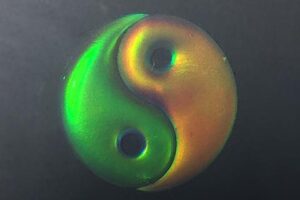 Source: Image courtesy of Yuanjin Zhao. Biocompatible, jelly-like materials that can repair themselves without losing their colour could find uses in photonics or biomedicine. The hydrogel can display structural colours and can self heal too, but uniquely this material doesn’t lose its structural colour when damaged. Scientists in China have created hydrogels that show self-repairing properties combined with lasting structural colours. This new class of material could be used for tissue engineering or to build photonic integrated circuits and biosensors. Many organisms – including birds, butterflies and beetles – display structural colours. These arise when light rays are scattered by tiny structures and then interfere with one another at certain wavelengths. This natural phenomenon has inspired researchers to create materials with similar optical properties. Hydrogels with structural colour have been made, but everyday use can damage these materials. If they could heal themselves that would be a solution, but it is challenging to retain their colours after healing.
Source: Image courtesy of Yuanjin Zhao. Biocompatible, jelly-like materials that can repair themselves without losing their colour could find uses in photonics or biomedicine. The hydrogel can display structural colours and can self heal too, but uniquely this material doesn’t lose its structural colour when damaged. Scientists in China have created hydrogels that show self-repairing properties combined with lasting structural colours. This new class of material could be used for tissue engineering or to build photonic integrated circuits and biosensors. Many organisms – including birds, butterflies and beetles – display structural colours. These arise when light rays are scattered by tiny structures and then interfere with one another at certain wavelengths. This natural phenomenon has inspired researchers to create materials with similar optical properties. Hydrogels with structural colour have been made, but everyday use can damage these materials. If they could heal themselves that would be a solution, but it is challenging to retain their colours after healing.
A team led by Yuanjin Zhao at Southeast University, Nanjing, now has an answer to this problem. The researchers fabricated a composite material consisting of a stable scaffold – prepared using a methacrylated gelatin hydrogel and silica nanoparticle templates – filled with a glutaraldehyde cross-linked bovine serum albumin hydrogel containing the enzymes glucose oxidase and catalase. The structural colour of the hydrogels is provided and maintained by the scaffold, which is composed of inverse opal photonic crystals – 3D periodic structures with photonic band gaps that locate and reflect light with certain wavelengths. The self-healing properties are supplied by the protein filler, which uses the reversible imine attachment of the glutaraldehyde cross-linker to lysine residues of the protein as a repair tool. The enzymes keep the self-healing process going by adjusting the pH of the system in the presence of glucose.
Zhao explains that the micro- and nanostructure of the hydrogels could be preserved in this way. Although the reflection properties were slightly affected at the joining points, the original colour was maintained throughout the rest of the material on both sides. ‘This could not be achieved in pure self-healing hydrogel systems because their neighbouring nanostructures tend to fuse together, causing the destruction of the periodic photonic scaffolds and the related structural colours,’ Zhao says. By using different sizes of silica nanoparticles for the templates, the researchers could produce hydrogels of different colours. The self-repairing properties of the materials also allowed them to create complex structures such as 3D integrated photonic paths or a yin and yang motif.
David Weitz, a physicist who studies soft condensed matter at Harvard University, US, says that the use of structural colours ‘makes the materials more robust and better able to use the light’. ‘In addition, they can renew themselves, automatically recovering from damage, providing a new means of assembly and making them much more robust for practical applications.’ Weitz points out that each component plays an important role: ‘The materials are very cleverly fabricated by combining properties of different ingredients,’ he says. The scaffold guarantees the structural stability of the hydrogels while the protein filler provides the self-repairing properties.
Zhao says that the new hydrogels could serve as building blocks for many applications. ‘Our method can be used to construct different kinds of composite materials with self-healing properties including materials for novel photonic circuits, tissue engineering biomaterials or biosensor materials.
